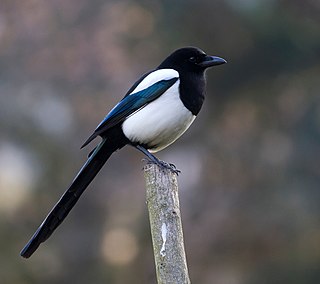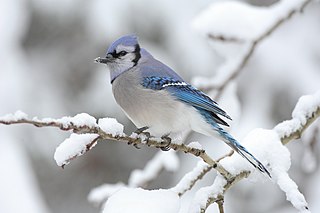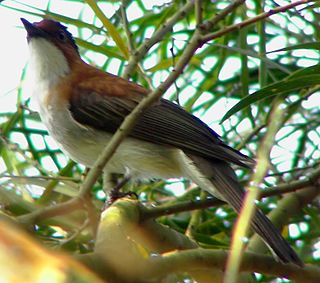
Magpies are birds of the Corvidae family. Like other members of their family, they are widely considered to be intelligent creatures. The Eurasian magpie, for instance, is thought to rank among the world's most intelligent creatures and is one of the few nonmammalian species able to recognize itself in a mirror test. They are particularly well known for their songs and were once popular as cagebirds. In addition to other members of the genus Pica, corvids considered as magpies are in the genera Cissa, Urocissa, and Cyanopica.

Corvidae is a cosmopolitan family of oscine passerine birds that contains the crows, ravens, rooks, magpies, jackdaws, jays, treepies, choughs, and nutcrackers. In colloquial English, they are known as the crow family or corvids. Currently, 135 species are included in this family. The genus Corvus containing 47 species makes up over a third of the entire family. Corvids (ravens) are the largest passerines.

The Australian magpie is a black and white passerine bird native to Australia and southern New Guinea. Although once considered to be three separate species, it is now considered to be one, with nine recognised subspecies. A member of the Artamidae, the Australian magpie is placed in its own genus Gymnorhina and is most closely related to the black butcherbird. It is not closely related to the European magpie, which is a corvid.

The Eurasian magpie or common magpie is a resident breeding bird throughout the northern part of the Eurasian continent. It is one of several birds in the crow family (corvids) designated magpies, and belongs to the Holarctic radiation of "monochrome" magpies. In Europe, "magpie" is used by English speakers as a synonym for the Eurasian magpie: the only other magpie in Europe is the Iberian magpie, which is limited to the Iberian Peninsula.

The Taiwan blue magpie, also called the Taiwan magpie, Formosan blue magpie, or the "long-tailed mountain lady", is a bird species in the crow family. It is endemic to Taiwan.

The red-billed blue magpie is a species of bird in the crow family, Corvidae. It is about the same size as the Eurasian magpie, but has a much longer tail, one of the longest of any corvid. It is 65–68 cm (25.5–27 in) long and weighs 196–232 g (6.9–8.2 oz).

Urocissa is a genus of birds in the Corvidae, a family that contains the crows, jays, and magpies.

The Sri Lanka blue magpie or Ceylon magpie is a brightly coloured member of the family Corvidae, found exclusively in Sri Lanka. This species is adapted to hunting in the dense canopy, where it is highly active and nimble. Its flight is rather weak, though, and is rarely used to cover great distances. In spite of the Sri Lanka blue magpie's ability to adapt to the presence of humans, it is classified as vulnerable to extinction due to the fragmentation and destruction of its habitat of dense primary forest in the wet zone of southern Sri Lanka.

The yellow-billed blue magpie or gold-billed magpie is a passerine bird in the crow and jay family, Corvidae. It forms a superspecies with the Taiwan blue magpie and the red-billed blue magpie. The species ranges across the northern parts of the Indian Subcontinent including the lower Himalayas, with a disjunct population in Vietnam.

The silver pheasant is a species of pheasant found in forests, mainly in mountains, of mainland Southeast Asia and eastern and southern China, with an introduced population on Victoria Island in Nahuel Huapi Lake, Neuquén, Argentina. The male is black and white, while the female is mainly brown. Both sexes have a bare red face and red legs. It is common in aviculture, and overall also remains common in the wild, but some of its subspecies are rare and threatened.

John Whitehead was an English explorer, naturalist and professional collector of natural history specimens in Southeast Asia. He is the first documented person to reach the summit of Mount Kinabalu: this was in 1888, after annual attempts from 1885.

The pied butcherbird is a songbird native to Australia. Described by John Gould in 1837, it is a black and white bird 28 to 32 cm long with a long hooked bill. Its head and throat are black, making a distinctive hood; the mantle and much of the tail and wings are also black. The neck, underparts and outer wing feathers are white. The juvenile and immature birds are predominantly brown and white. As they mature their brown feathers are replaced by black feathers. There are two recognised subspecies of pied butcherbird.

The white-throated magpie-jay is a large Central American species of magpie-jay. It ranges in Pacific-slope thorn forest from Jalisco, Mexico to Guanacaste, Costa Rica. Magpie-jays are noisy, gregarious birds, often traveling in easy-to-find flocks, mobbing their observers.

The Oriental magpie is a species of magpie found from south-eastern Russia and Myanmar to eastern China, Korea, Taiwan, Japan and northern Indochina. It is also a common symbol of the Korean identity, and has been adopted as the "official bird" of numerous South Korean cities, counties and provinces. according to a Korean folktale, magpies formed a bridge to help two star-crossed lovers reunite. The magpie was chosen as the national bird of Korea in 1964, after receiving a substantial amount of votes in a national contest. Other names for the Oriental magpie include Korean magpie and Asian magpie.

The Chinese hwamei or melodious laughingthrush is a passerine bird of eastern Asia in the family Leiothrichidae. The name "hwamei" comes from its Chinese name 畫眉, which means "painted eyebrow", referring to the distinctive marking around the bird's eyes. The species is a popular cagebird because of its attractive song.

The chestnut bulbul or chestnut-backed bulbul is a songbird in the bulbul family, Pycnonotidae. The species was first described by Robert Swinhoe in 1870. It is found in southern China and northern Vietnam. Its natural habitat is subtropical or tropical moist lowland forests.
The white-naped monarch is a species of bird in the family Monarchidae. It is endemic to Indonesia, where it occurs in the Maluku Islands. Its natural habitat is subtropical or tropical moist lowland forests.

The Chinese nuthatch or snowy-browed nuthatch is a species of bird in the family Sittidae. It is a small nuthatch, measuring 11.5 cm (4.5 in) in length. The upperparts are blue-gray and the underparts from a dull buff-grayish to a cinnamon-orange; the cheeks are white. There is a marked sexual dimorphism: the adult male is distinguished by its very black crown, while that of the female is the same blue-grey as the back, or at most dark gray when the plumage is worn. In both sexes, a dark gray eyestripe extends in front of and behind the eye, topped by a clear white supercilium separating it from the crown. The song is variable, and composed of repetitions of small invariant whistles. The species feeds mainly on insects in summer and completes its diet with seeds and fruits. The nest is generally placed in the hole of a conifer. The pairs raises one brood per year, with five or six chicks.

The chestnut-faced babbler is a species of bird in the white-eye family Zosteropidae. It is endemic to the island of Luzon in the Philippines. There are two subspecies, Z. w. whiteheadi in northern and central Luzon, and Z. w. sorsogonensis in southeastern Luzon. The species is generally found in mountain forests, generally above 1000 m. Within its range it is catholic in its choice of habitat, frequenting broadleaf forests, moist mossy forests, pine forest, open forest, scrub and human modified habitat as well.

Whitehead's trogon is a species of bird in the family Trogonidae. It is endemic to the island of Borneo, where it is an uncommon resident in primary mountain forest. One of Borneo's largest trogons at 29 to 33 cm long, it is sexually dimorphic. The male is crimson on the head, nape, and underparts, with a black throat and grey chest; the rest of his upperparts are cinnamon-coloured. The female is similarly patterned, but cinnamon-brown where the male is scarlet. The species was first described for science by Richard Bowdler Sharpe in 1888, who named it for British explorer and collector John Whitehead. There are no subspecies.



















